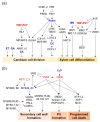Current Understanding of the Genetics and Molecular Mechanisms Regulating Wood Formation in Plants
- PMID: 35885964
- PMCID: PMC9319765
- DOI: 10.3390/genes13071181
Current Understanding of the Genetics and Molecular Mechanisms Regulating Wood Formation in Plants
Abstract
Unlike herbaceous plants, woody plants undergo volumetric growth (a.k.a. secondary growth) through wood formation, during which the secondary xylem (i.e., wood) differentiates from the vascular cambium. Wood is the most abundant biomass on Earth and, by absorbing atmospheric carbon dioxide, functions as one of the largest carbon sinks. As a sustainable and eco-friendly energy source, lignocellulosic biomass can help address environmental pollution and the global climate crisis. Studies of Arabidopsis and poplar as model plants using various emerging research tools show that the formation and proliferation of the vascular cambium and the differentiation of xylem cells require the modulation of multiple signals, including plant hormones, transcription factors, and signaling peptides. In this review, we summarize the latest knowledge on the molecular mechanism of wood formation, one of the most important biological processes on Earth.
Keywords: biomass; secondary growth; vascular cambium; wood formation; xylem differentiation.
Conflict of interest statement
The authors declare no conflict of interest.
Figures


Similar articles
-
WUSCHEL-RELATED HOMEOBOX genes are crucial for normal vascular organization and wood formation in poplar.Plant Sci. 2024 Sep;346:112138. doi: 10.1016/j.plantsci.2024.112138. Epub 2024 May 31. Plant Sci. 2024. PMID: 38825043
-
The role of senescence-associated gene101 (PagSAG101a) in the regulation of secondary xylem formation in poplar.J Integr Plant Biol. 2022 Jan;64(1):73-86. doi: 10.1111/jipb.13195. J Integr Plant Biol. 2022. PMID: 34845845
-
Arabidopsis as a model for wood formation.Curr Opin Biotechnol. 2011 Apr;22(2):293-9. doi: 10.1016/j.copbio.2010.11.008. Epub 2010 Dec 6. Curr Opin Biotechnol. 2011. PMID: 21144727 Review.
-
Molecular control of wood formation in trees.J Exp Bot. 2015 Jul;66(14):4119-31. doi: 10.1093/jxb/erv081. Epub 2015 Mar 5. J Exp Bot. 2015. PMID: 25750422 Review.
-
Developing xylem-preferential expression of PdGA20ox1, a gibberellin 20-oxidase 1 from Pinus densiflora, improves woody biomass production in a hybrid poplar.Plant Biotechnol J. 2016 Apr;14(4):1161-70. doi: 10.1111/pbi.12484. Epub 2015 Oct 26. Plant Biotechnol J. 2016. PMID: 26503830 Free PMC article.
Cited by
-
Exploring the Seasonal Dynamics and Molecular Mechanism of Wood Formation in Gymnosperm Trees.Int J Mol Sci. 2023 May 11;24(10):8624. doi: 10.3390/ijms24108624. Int J Mol Sci. 2023. PMID: 37239969 Free PMC article. Review.
-
Insights into Molecular Mechanism of Secondary Xylem Rapid Growth in Salix psammophila.Plants (Basel). 2025 Feb 5;14(3):459. doi: 10.3390/plants14030459. Plants (Basel). 2025. PMID: 39943021 Free PMC article.
-
Deep tissue profiling of Populus stem at single nucleus level reveals uncharacterized cell types and cell-specific gene regulatory networks.Genome Biol. 2025 Aug 28;26(1):258. doi: 10.1186/s13059-025-03728-x. Genome Biol. 2025. PMID: 40877938 Free PMC article.
-
Genome-wide identification and expression analysis of GDP-D-mannose pyrophosphorylase and KATANIN in Corymbia citriodora.Front Plant Sci. 2023 Dec 18;14:1308354. doi: 10.3389/fpls.2023.1308354. eCollection 2023. Front Plant Sci. 2023. PMID: 38186597 Free PMC article.
-
Differential gene expression analysis reveals the fast-growth mechanisms in Melia dubia at different stand ages.Mol Biol Rep. 2023 Dec;50(12):10671-10675. doi: 10.1007/s11033-023-08873-9. Epub 2023 Nov 7. Mol Biol Rep. 2023. PMID: 37934367
References
-
- Rajput K.S., Gondaliya A.D., Lekhak M.M., Yadav S.R. Structure and Ontogeny of Intraxylary Secondary Xylem and Phloem Development by the Internal Vascular Cambium in Campsis radicans (L.) Seem. (Bignoniaceae) J. Plant Growth Regul. 2018;37:755–767. doi: 10.1007/s00344-017-9771-x. - DOI
Publication types
MeSH terms
LinkOut - more resources
Full Text Sources
Research Materials

